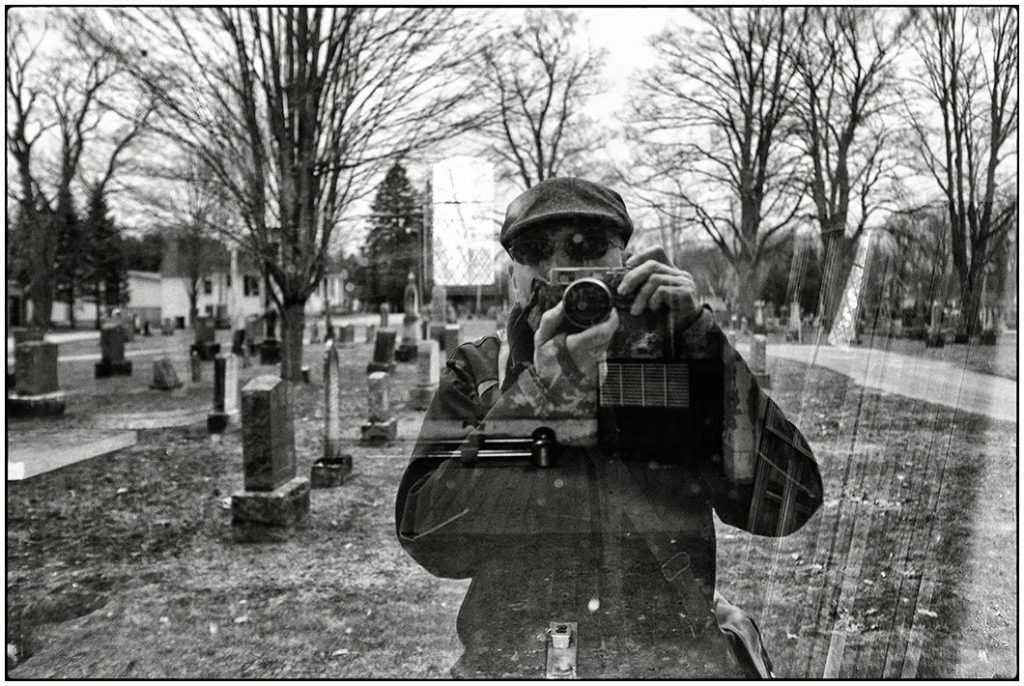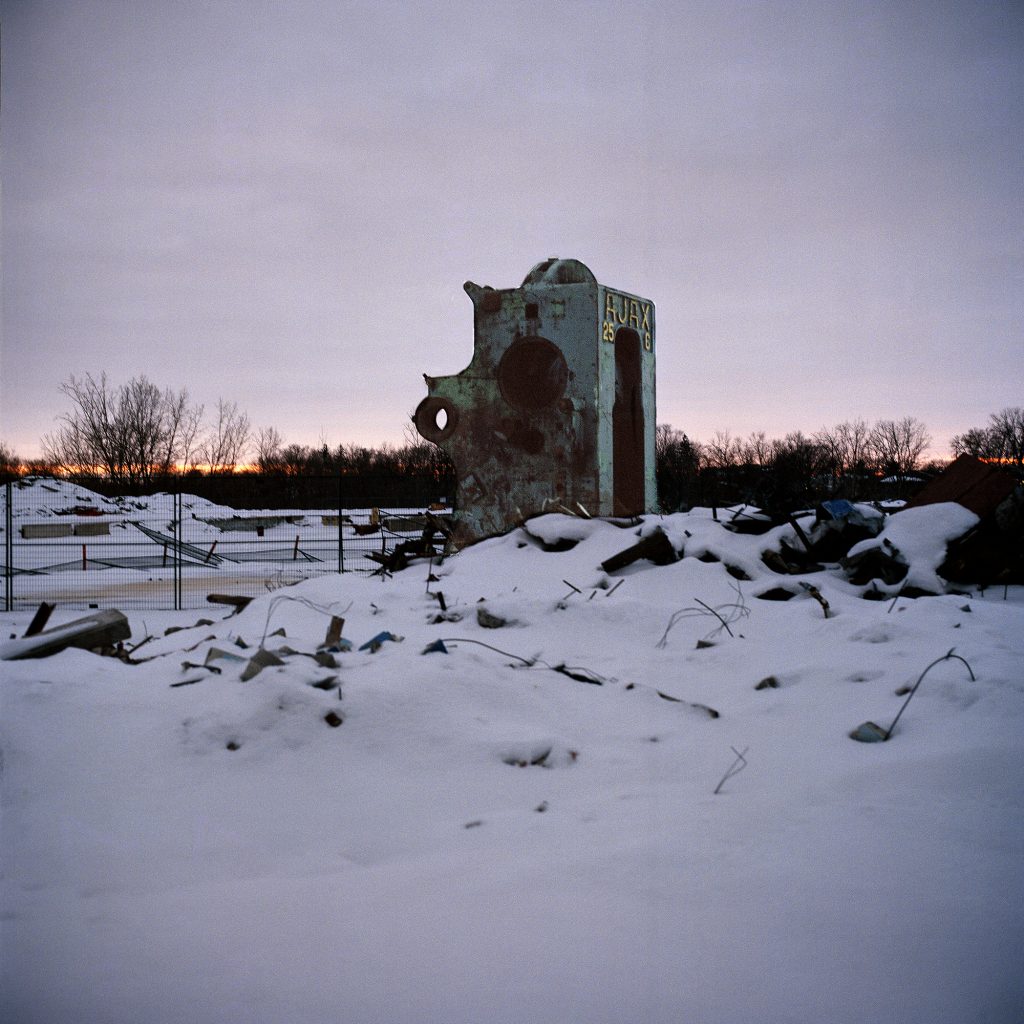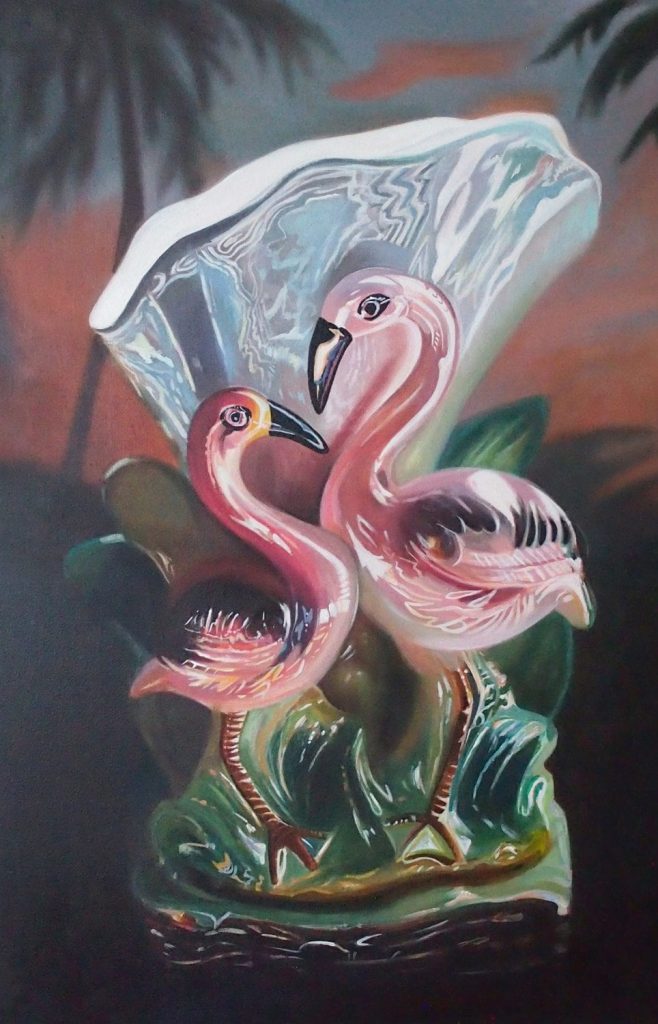In: Niagara

Dave Green | Self portrait in the window of the Greenwood Cemetery chapel, Owen Sound, 2024
April 12, 2024Dave Green | Self portrait in the window of the Greenwood Cemetery chapel, Owen Sound, 2024
‘Time is nothing. We have our memory. In memory there is no time. I will hold you in my memory.
And you, maybe you will remember me too.’
(J.M. Coetzee, The Pole)
There is a Salvatore DiFalco quality to Dave Green’s photographs. It’s not just the scenes he presents us, but also the deep almost oily blacks and the grain of the film in many of his photographs. There is a physicality to these scenes, even when seen online : unsurprising, as he’s a photographer who is all about the photographic print and not just within the digital milieu of the present day, that has both its advantages and failings….
DiFalco is a writer and literary critic : I first encountered his fiction in a Canadian literary magazine in the early 2000s and this inspired me to seek out his book of short stories Black Rabbit & Other Stories.
These are urban stories, gritty snapshots of people who are frequently flawed and even, perhaps, a bit repellent. They take place in Toronto or Hamilton or even my own territory of the rust belt wonderland of Niagara, and several memorable ones that are situated in the latter two sites are as engaging as they are grotesque. The characters that inhabit DiFalco’s Black Rabbit (from Stories or Outside or Rocco or Alicia) could also populate some of the scenes that Green presents to us. Green’s work is not quite so dire or dour, nor quite as nihilistic, but his photographs do intersect with DiFalco’s world, whether literally (in his choice of places or his on the cuff captures of his immediate world) or through implication, with the unembellished frankness of Green’s photographs.
Death is also close in DiFalco’s stories : and the image that spurred this response to Green’s work – Self portrait in the window of the Greenwood Cemetery chapel, Owen Sound, 2024 – also speaks to an affinity, if not a comfort, with stark endings and perhaps remembrance, perhaps not.
From the artist’s site : Dave Green was born in Toronto (1963), Ontario and grew up in the small Southern Ontario city of Owen Sound. In the early 1980s he moved back to Toronto to study photography at Ryerson Polytechnical Institute (now Toronto Metropolitan University). He has worked as a house painter, a fibreglass worker, a photography technician and as an educator. He served as an instructor of photography at Ryerson’s Chang School of Continuing Education and has taught photography to youth affected by violence. He has travelled extensively throughout Canada, the United States and Europe, always with a camera.
The words of LP Farrell, from the introduction to Green’s book Personal (Dumagrad Books, 2017):
Looking at some of these photographs now, the prescience startles and the storefront facade windows, the tired barren highways, the sombre diners seem less a lament or nostalgic yearning for a different time, which is what I thought back then, than a crystal ball, sometimes literally reflecting, but often revealing a life marked by deep solitude. It is as though Dave saw, understood and then showed us what would happen to us all before life hit. Dave Green has photographed a world already disappearing like a picture not quite fixed, time remorseless and unrelenting. Time doing its thing.
———————————————————
This is a book of contrasts, the tension in the dialogue a whisper. Look here: youthful lust and yearning, women and lovers juxtaposed with landscapes busted and stripped down. Lust is a counterpoint to dilapidation. The tang of tungsten light in cavernous bars and then a street lamp, suddenly a votive light in a night sky over lovers like some crazy benediction. As if there was hope…
You can see more of Green’s work at his site here and his IG is here. Green is also represented by the MF Gallery.
If there is a reckoning, it is on the road. The photographer/passenger, the night and a beautiful woman at the wheel; a motorcyclist with a life garbage-bagged and strapped to the saddle of his BSA, maybe in flight. A bleak stretch of road ahead, road the arbiter. Love goes but the road always stays. Road, the redeemer.
LP Farrell, from the introduction to Green’s book Personal (2017)
They drove in silence, the landscape a work in charcoals and flaked quartz.
———–
What the fuck did he just do? He stopped running. He was out of breath.
He looked around him. He was standing nowhere.
(Salvatore DiFalco, from the short story Pink, from Black Rabbit & Other Stories)
I’ll end with how I feel an affinity for Green’s images of the rust belt wonderland : I could be looking at the streets I haunt in St. Catharines or Welland, and even the older images from the 1980s offer a run down weariness, a punky nostalgia, that I also remember from my youth in Niagara. I see echoes of Chris Killip or Tish Murtha, in the images of Dave Green as much as I see my own city, too.
~ Bart Gazzola
Read More
Julianna D’Intino | Connecting Rods: A Survey of Industry in the Niagara Region, 2015 – 2022
September 22, 2022Julianna D’Intino | Connecting Rods: A Survey of Industry in the Niagara Region, 2015 – 2022
To talk of the legacy of GM when you live in the city of St. Catharines is akin to how your tongue will always go to the gap in your teeth, seeking something that was there and now is not, leaving nothing behind but a perceptible absence you are unable to ignore.
Julianna D’Intino’s images, both moving and still – and I’ve been lucky enough to see several bodies of work she’s produced – often have a local focus, and in some ways she steps into that role of photographer as social historian. Often this involves her adjacent community in Niagara, exploring her own immediate heritage and circle. One such series can be seen here.
Connecting Rods: A Survey of Industry in the Niagara Region is a family story, as well as a local one. The ‘connection’ in the title of this series is not just a nod to an industrial interpretation, but also the families, communities and city that is part of a network that once had its epicenter in the abandoned wastelands D’Intino presents us with….and in her fine words about this series, D’Intino also draws connections to other areas with similar experience, such as with Atlas Steels or John Deere in Welland.
That potential for ‘nostalgia’ doesn’t mean what D’Intino is telling us is through rose – coloured glasses, nor does it gloss over the reality: her words about this work are as unflinching and honest – and engaging – as her photographs.
“This is but one personal case study in the myriad of lost industry of the Niagara Region. Would the return of the Niagara Region as a manufacturing hub provide a sustainable solution to the region’s economic woes? No, it would not. What is missing in the region is sufficient work at wages high enough to sustain a well-balanced life at the Niagara Region’s new inflated cost of living. The last time that such security was widespread was when manufacturing was a leading industry.”
The legacy of GM in St. Catharines is surely a contested narrative, with ground fertile for those from here – like D’Intino, or myself – to mine. It’s as rife as the industrial damage left behind at the site (an ongoing issue in civic politics here which has led to some grotesque and unsettling bedfellows), and there are differing opinions in play. Anna Szaflarski, for example, offers another perspective on this history here.
D’Intino’s site is here, and more images and D’Intino’s considered words about Connecting Rods can be found here.
~ Bart Gazzola
Read More
Pink Flamingos, from Melanie MacDonald’s series Florida Noir, 2017
June 28, 2021Pink Flamingos, Melanie MacDonald, from the Florida Noir series, 2017
Melanie MacDonald’s Florida Noir series is comprised of many exquisitely painted works that evoke a multiplicity of responses, such as Pink Flamingos. When we spoke about these paintings, literary references peppered our conversation. MacDonald cited Douglas Coupland (who sometimes fancies himself an artist, and some fancy as a cultural prognosticator): “Florida isn’t so much a place where one goes to reinvent oneself, as it is a place where one goes if one no longer wished to be found.” I found myself ‘speaking’ that ‘Florida is going to dissolve into madness and alligators and toxic waste’, channeling Neil Gaiman’s American Gods. MacDonald paints trinkets of the utopian dream too often projected onto Florida (as in the desperate film noir Midnight Cowboy: “It’s not, not bad, huh? There’s no heat here, but you know, by the time winter comes, I’ll be in Florida.”). In her Florida Noir series, the kitschy, almost disposable trinkets so often dismissed as touristy ‘trash’ become interesting and contested motifs for memory, or even how ‘landscape’ (with all the history and myths in that genre, real or imagined) can be encapsulated in an oft – dismissed gauche ‘souvenir’ or mundane bit of porcelain. You can see more of her work here, and read more about her practice here. ~ Bart Gazzola
Read More
Rebecca from Alec Soth’s series Niagara, 2005
June 9, 2021Alec Soth, Rebecca, from the series Niagara, 2005
Soth’s images from his Niagara series are contradictions, and though he employs Niagara, N.Y., it might as well be Niagara Falls, ON, as I see the latter, familiar to me both as a child and adult, as well. There’s the obligatory tourist shots of the Falls, but these seem like fanciful ideals when contrasted with the motel facades and the people he captures, which are grittier. This is the real Niagara I know: a site that seems darker than the postcards, or a honeymoon long since gone stale. These are scenes that have much in common with films like Disappearance at Clifton Hill (2019), Niagara Falls (1953) or Falling Angels (2003) – in that last, it looms in the subtext, only seen near the end, but a site of death, perhaps accidental, perhaps intentional. Soth’s people and places might be illustrations for Cataract City (2013), a tale of desperation also about a place that has a thin shiny veneer, already worn and flaking before we even scratch at it further.
A final note: a contemporary photographer in Niagara is offering what might be considered an update on Soth’s vision. Jon Lepp’s The Official Open for Business Series is like checking in, on Soth’s Niagara, and the irony of the title is appropriately bleak, like the world of Soth’s Rebecca, that her child also now inhabits.~ Bart Gazzola
Read More
Recent Comments